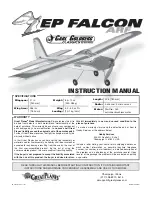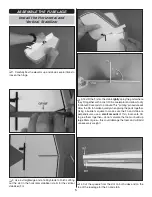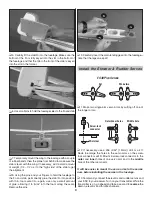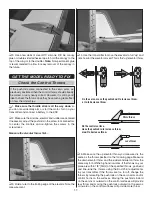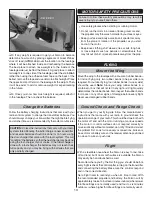
13
❏
3. If any weight is required to get your Falcon to balance,
determine how much by placing segments of Great Planes
“stick on” lead (GPMQ4485) over the location on the fuselage
where it will be attached inside and rechecking the balance.
The best place to attach nose-weight is to the inside of the
fuselage side just behind the fi rewall. A good place to attach
tail weight is to one side of the fuselage under the stab.
Hint:
rather than using the adhesive foam tape on the back of the
ballast, remove the tape and use Velcro to attach weight. Place
the opposite strip of Velcro in the fuselage for the weight. Then,
it will be easier to add or remove weight for experimenting
in the future.
❏
4. Once you know how much weight is required, attach it
in the fuselage. Then, recheck the balance.
Charge the Batteries
Follow the battery charging instructions that came with your
radio control system to charge the transmitter batteries. You
should always charge your transmitter the night before fl ying,
and at other times as recommended by the radio manufacturer.
CAUTION:
Unless the instructions that came with your radio
system state differently, the initial charge on new transmitter
and receiver batteries should be done for 15 hours using
the slow-charger that came with the radio system. This will
"condition" the batteries so that the next charge may be done
using the fast-charger of your choice. If the initial charge is
done with a fast-charger the batteries may not reach their
full capacity and you may be fl ying with batteries that are
only partially charged.
MOTOR SAFETY PRECAUTIONS
Failure to follow these safety precautions may result in
severe injury to yourself and others.
•
Use safety glasses when starting or running motors.
•
Do not run the motor in an area of loose gravel or sand;
the propeller may throw such material in your face or eyes.
• Keep your face and body as well as all spectators away
from the plane of rotation of the propeller as you start
and run the motor.
• Keep loose clothing, shirt sleeves, ties, scarfs, long hair
or loose objects such as pencils or screwdrivers that
may fall out of shirt or jacket pockets away from the prop.
FLYING
Mount the Wing
Mount the wing to the fuselage with a couple of rubber bands—
for indoor fl ying only two rubber bands (one per side) are
required. For outdoor fl ying, four rubber bands (two per side)
should be used.
Note:
Store your wing rubber bands in a
container or box that will not let in any light—UV light quickly
deteriorates the rubber bands. Also inspect the rubber bands
for cracks or any other signs of damage before every fl ight.
Never use damaged rubber bands.
Ground Check and Range Check
When you get to your fl ying site follow the manufacturer's
instructions that came with your radio to ground check the
operational range of your radio. This should be done both with
the motor off and with the motor running at various speeds.
If the motor or control surfaces do not respond correctly or
move erratically without command, do not fl y! Find and correct
the problem fi rst. Look for loose servo connections, broken or
loose motor or battery wires or the receiver antenna positioned
too close to wires or pushrods.
Flight
With a steerable nose wheel the Falcon is easy to taxi, take
off and land, but if no smooth surface is available the Falcon
may easily be hand-launched as well.
No matter where you fl y, the fi rst thing you should do before
every fl ight is check the controls after turning on the transmitter
and connecting the battery. Make sure the controls respond
and in the correct direction.
Set a fl ight timer to remind you when it’s time to land. With
the recommended propeller and battery, the Falcon will fl y
approximately twelve to fourteen minutes indoors (where lower
throttle settings are normally used) and four to six minutes
outdoors (where higher throttle settings are normally used).
Содержание EP FALCON ARF
Страница 16: ......

